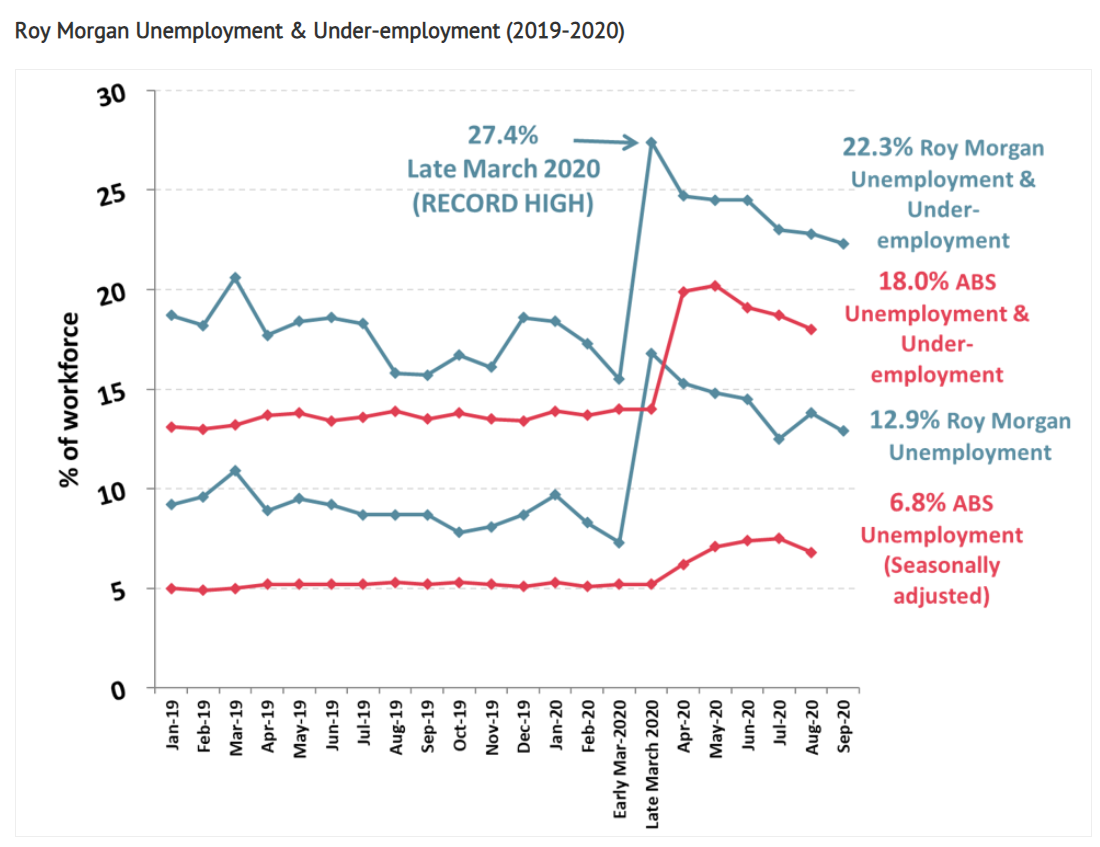Roy Morgan has released its unemployment estimate for September, which reports that Australia’s unemployment rate fell by 0.9% in September to 12.9%. However, underemployment rose by 0.4% to 9.4%:

Unemployment was down 3.9% from its late March peak (16.8%), whereas underemployment was 1.2% lower from its late March peak (10.6%).
However, the fall in unemployment “is not good news” according to Roy Morgan, because “more people have stopped looking for work”:
The workforce is down:
The workforce in September was 14,148,000 – comprised of 12,320,000 employed and 1,828,000 unemployed Australians looking for work. The workforce total is down 208,000 since August driven by falls in both full-time employment and unemployed Australians.
Fewer Australians employed:
12,320,000 Australians were employed, down 56,000 from August including 7,991,000 employed full-time, down 160,000, and 4,329,000 employed part-time, up 104,000.
Fewer Australians looking for work:
1,828,000 Australians were looking for work (12.9% of the workforce), down 152,000 from August. There were fewer people looking for full-time work, down 36,000 to 732,000 – the fifth straight month of declines for this indicator since peaking in April over 1 million, fewer looking for part-time work, down 116,000 to 1,096,000.
Roy Morgan’s unemployment figure of 12.9% for September is significantly higher than the current ABS estimate for August 2020 of 6.8%. However, the ABS figure for August estimated a large decline in the size of the workforce since March which they said was down 232,000. The ABS also counted an additional 152,000 Australians who were working zero hours in August as ‘employed’; people who ‘had no work, not enough work available, or were stood down’. If these non-workers are added the ABS unemployment estimate for August increases to 1.33 million (9.7%).
CEO Michele Levine says:
“Roy Morgan’s unemployment measure for September shows 1.83 million Australians were unemployed (12.9% of the workforce) with an additional 1.33 million (9.4%) under-employed. In total 3.16 million Australians (22.3%) were unemployed or under-employed – down 112,000 on a month ago”…
“Unemployment decreased in September driven by falls across all States apart from locked down Victoria with unemployment virtually unchanged on a month ago at 12.1%. However, the drop in unemployment was driven by a contracting workforce rather than a surge in new jobs”…
“The decrease in the headline unemployment figure (from 13.8% to 12.9%) is NOT good news. The decrease in unemployment reflects the disturbing situation where more people have stopped looking for work. In September there were 56,000 fewer jobs or employed people and 152,000 fewer people looking for jobs. It’s a strange mathematical conundrum that we could have no unemployment – if everyone without a job simply gave up looking. Clearly this was never the intent of the unemployment metric.
“At a time like now – when jobs are held open, and the economy is held up by Government support, the metrics like ‘unemployment’, ‘employment’ and ‘the workforce’ take on very different meanings. What we call ‘the workforce’ is simply the sum of employed people plus people who are looking for work (unemployed). What about those who are employed but ‘stood down’ on JobKeeper – like a ‘holding pen’ waiting for their job to come back so they join the ‘employed’ or waiting to find they have no job – their employer no longer exists, or their job no longer exists, or their employer no longer needs them or can no longer afford them – so they join the ‘unemployed’.
“The Roy Morgan unemployment data suggests most of these people are not looking for work. Indeed the data shows fewer people are now looking for work than last month, even though fewer now have jobs. This means the Australian workforce has shrunk”…
“The reduction in Government support is forcing businesses that have relied upon these payments to continue trading over the last few months to assess how many of their employees are vital to the business and which may be too costly to continue to employ without the Government payments”.
It will be interesting to see how the unemployment rate reacts as JobKeeper is unwound.
The way it is shaping up, it looks like Australia’s labour market is headed for an L-shaped recovery.

